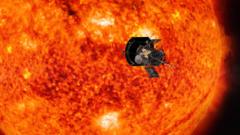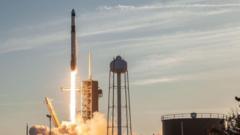The Parker Solar Probe is set to achieve a record-breaking close encounter with the Sun, enduring extreme conditions in a quest to understand solar activity and its impacts on Earth.
NASA's Parker Solar Probe Makes Historic Close Approach to the Sun

NASA's Parker Solar Probe Makes Historic Close Approach to the Sun
NASA's pioneering spacecraft embarks on its closest pass to the Sun, seeking to unlock the mysteries of solar phenomena.
NASA's Parker Solar Probe is making a groundbreaking attempt to approach the Sun more closely than any spacecraft has ever done before. As it ventures into our star's outer atmosphere, the probe is bracing for extreme heat and radiation levels that could pose significant risks. Communication with the probe is temporarily suspended during this daring fly-by, and scientists expect to receive a signal confirming its status on December 27.
The goal of this mission is to gather vital data that will enhance our understanding of the Sun. Dr. Nicola Fox, head of science at NASA, emphasized the importance of experiencing the Sun's atmosphere directly, stating, "For centuries, people have studied the Sun, but you don't experience the atmosphere of a place until you actually go visit it."
Launched in 2018, the Parker Solar Probe has already completed 21 passes of the Sun and will set a new record during its Christmas Eve approach, coming within approximately 3.8 million miles (6.2 million km) of the Sun's surface. While this distance might not seem trivial, Dr. Fox provided a relatable analogy, explaining that if the Earth and the Sun were just one meter apart, the probe would be a mere four centimeters from the Sun—an incredibly close distance.
To protect itself from the intense conditions, the spacecraft is equipped with an 11.5 cm (4.5 inches) thick carbon-composite shield. The probe will navigate this hazardous environment quickly, traveling at a staggering speed of 430,000 mph, which is comparable to flying from London to New York in under 30 seconds.
Why go to such lengths? Scientists are keen to unravel the enigma of the solar corona, which is significantly hotter than the Sun's surface. Dr. Jenifer Millard from Fifth Star Labs explained, "The corona is really, really hot, and we have no idea why." Understanding how the Sun's outer atmosphere reaches temperatures in the millions of degrees is critical, especially since these corona phenomena can impact space weather and subsequently affect Earth.
Interactions between the solar wind—a continuous stream of charged particles emitted from the corona—and Earth's magnetic field can lead to stunning auroras as well as disruptions to power grids and communication systems. Thus, understanding the Sun's behavior is crucial for modern life on Earth.
As scientists await the probe's signal over the Christmas holiday, Dr. Fox expressed both excitement and anxiety about the upcoming transmission. She humorously noted that her team plans to text her a green heart emoji once the probe sends confirmation that it is unharmed. Despite her concerns, Dr. Fox assured public confidence in the probe's design, affirming, "It's a tough, tough little spacecraft," ready to face the Sun's brutal conditions.




















